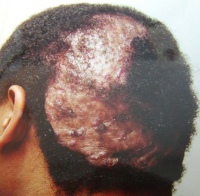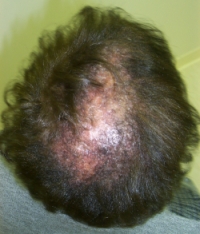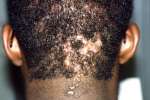Scalp Diseases

There are many scalp diseases associated with itching, soreness or tenderness of the scalp that can lead to chronic irritation and damage to hair follicles resulting in hair loss.Untreated, these scalp diseases can even lead to permanent baldness oftentimes without your being aware that this is happening.
1. Seborrheic Dermatitis
Dry, itchy, flaky patches occur on the scalp, especially around the hair margins in the front and on the sides and in the back. This condition is one of the scalp diseases that does not usually cause hair loss, but with chronic rubbing and scratching the hair can begin to thin around the edges. Up to 30% of the population is affected with seborrheic dermatitis, but most do not know the condition by name. It can come and go with flare ups occurring during the winter months when it is cooler and drier. It can also flare up in association with stress and anxiety such as that due to exams in school, deadlines at work, sales quotas to meet, or financial difficulties.
While hard to explain, this scalp disease can also be associated with scaling and flaking inside of or behind the ears, of the eyebrows, on the sides of the nose, in the beard and moustache areas as well as in the middle of the back or the area between the breasts. Usually an individual does not have all possible areas affected at one time, but it is common for the scalp and face to be affected together. This condition does not spread by transferring it from one part of the body to another or from person to person. It is genetic and frequently affects multiple family members in different generations. The earliest form of seborrheic dermatitis is cradle cap which develops during infancy.
2. Neurodermatitis
This is one of the scalp diseases that starts out as a localized area of itching on an area of the scalp that looks normal. Over a period of time, the itchy spot can enlarge as well as become more and more bothersome. For some peculiar reason it tends to occur primarily in the middle of the top of the scalp or along the back of the hairline. Repeated scratching and rubbing of the area lead to hair breakage and a characteristic localized patch of shorter broken off hair. Neurodermatitis can be mild causing occasional itching, moderate, or severe with ongoing continuous deep itching that never seems to go away.
The true cause of this scalp disease is not known, but stressful events and situations definitely aggravate it and make it get worse. With repeated rubbing and scratching, the skin can become thickened and darkened so that another condition called lichen simplex chronicus is present. Once this condition becomes more severe it can be very difficult to stop it. Medical treatment with localized cortisone injections, oral anti-itch medication, and topical prescription products can give considerable relief and control the problem. Once the itching stops, then the hair can start to grow back in the affected areas. It can take 6 to 12 months for hair growth to return to normal depending upon how quickly your hair grows on a normal basis.
3. Psoriasis
Psoriasis belongs to a group of scalp diseases that are characterized by thick silvery scaly areas developing on various parts of the body. The scalp is one of the areas that is frequently affected by psoriasis. The degree of involvement can range from a small area the size of a dime to near total involvement of the scalp surface. Despite extreme amounts of scaling and flaking, many individuals affected with psoriasis never have any itching and never have any hair loss. The psoriasis process is related to an ongoing overproduction of skin cells in the upper layer called the epidermis. This process does not affect hair follicles themselves either directly or indirectly.
Since part of the treatment for psoriasis involves frequent shampooing, African American females may have more hair loss issues due to the treatment for psoriasis rather than the psoriasis itself. It is important to use medications that can help improve the condition without drying out the hair and causing it to become brittle and break easily. Also, trying to scratch the flakes out can really make this condition worse. Psoriasis is associated with a process called the “Koebner Phenomenon”; because of this feature, anything that causes injury to the skin such as aggressive scratching to try and get the flakes out will trigger the psoriasis and lead to more and more flakes being produced. So if you have psoriasis, do not try to scratch the flakes out!!!
4. Bacterial Folliculitis
This is a member of the group of scalp diseases associated with the overgrowth of harmful bacteria inside of hair follicles. This shows up on the scalp as pus containing bumps with a hair growing out of the middle of them. The degree of involvement can range from one single hair bump to diffuse involvement of the scalp with hundreds of infected hair follicles present.
Pain is one of the key symptoms associated with bacterial infection of the scalp so if you are affected you might notice tenderness to the touch or sore spots when combing or brushing your hair. At times the lesions can actually bleed or drain a liquid material.
5. Dissecting Cellulitis

This is one of several rare scalp diseases that are associated with the development of large areas of thickening of the scalp in association with pockets of pus trapped under the skin. While pus is usually associated with the presence of bacteria and infection, in dissecting cellulitis, some of these areas are bacteria free.
This condition can be very aggressive leading to large areas of hair loss which have a high possibility of causing scarring and permanent baldness due to the fact that this condition affects the deeper portions of the scalp.
6. Traction Folliculitis
Prolonged tension and pulling on the hair can lead to scalp diseases associated with injury in susceptible individuals. The earliest sign of injury is localized scaling, flaking, and pus bumps that develop around the base of the hairs that are affected. Amazingly, these areas don’t usually itch or hurt despite significant inflammation being present.
If the source of the tension is not eliminated, and the condition continues on a chronic basis then scarring can occur which is called traction alopecia.
7. Discoid & Systemic Lupus
There are two primary ways in which scalp diseases and hair loss occur with lupus. The first type of hair loss is diffuse shedding of long strands of hair. The tips usually have a white bulb, but there is not usually a bald spot. An effected individual will usually have symptoms such as high fever, fatigue, or anemia due to a flare of systemic lupus. When the illness gets under control, the shedding will eventually stop. However, this type of hair loss can continue for 8 to 12 months after the illness is in remission. So, it can take up to a year or more for the hair growth to get back to normal.

The second type of hair loss that occurs is called "Discoid Lupus". This version is associated with patchy areas on the scalp with red, brown, or white discoloration and bald spots. The scalp can be tender, itchy, scaly, or crusted. This condition causes injury to hair follicles which can lead to scarring and permanent baldness, which is known as cicatricial alopecia . Early medical treatment with oral or topical or localized injections can help to heal this condition and minimize hair loss. Sometimes a skin biopsy is necessary to make a diagnosis.
8. Hair Shaft Defects
Medical conditions that cause a physical change in the structure or strength of individual strands of hair are called hair shaft defects. An individual hair fiber is made up of several different layers including the cortex, inner root sheath, outer root sheath, and cuticle. When a defective hair is produced due to an alteration in development of the strands, a hair shaft defect occurs.
Conditions that belong to this group include Trichorrhexis Nodosa, Trichonodiosis, Netherton’s Syndrome, and Menke’s Kinky Hair Syndrome. Special microscopic features are used to make diagnosis of hair shaft defects and to make recommendations for treatment.
9. Tinea Capitis
This is the medical term for ringworm or fungus infections of the scalp. Theses types of infections are forms of scalp diseases that can cause only mild flaking that looks like dandruff, or patches of hair loss with itching and flaking or areas of infection with pus bumps or red swollen lumpy areas on the scalp.
While many topical antifungal medications are available over the counter, it is usually necessary for medication to be taken internally to clear most of these scalp infections. Early treatment can prevent the possibility of permanent hair loss when the disease process becomes more advanced.
10. Acne Keloidalis Nuchae
Scalp diseases associated with the development of bacterial infection and keloid development most often at the back of the scalp along the hairline. The majority of individuals affected with this condition are males who get the condition because of localized trauma due to sharp razors or clippers. However, this condition also occurs in females who have never used a razor or edged up the hair along the neckline.
Once the individual hair follicles become infected keloid formation can occur causing hard bumps of scar tissue. The process can remain localized or it can continue to spread and create larger growths of scar tissue and subsequent hair loss. It is important to eliminate the cause of the condition as well as treat it early to stop pain, itching, bleeding, and progressive damage to hair follicles.
11. Alopecia Areata
This is one of the most commonly known types of hair loss and it is what many people refer to when they use the term “Alopecia”. It is characterized by the appearance of smooth patches of baldness that can be as small as an eraser or the size of a quarter or can progress to involve the entire scalp (alopecia totalis).
While it is quite common, the cause of alopecia areata is unknown, but thought to be related to scalp diseases associated with autoimmune conditions that effects the hair follicles. The hair can grow back sometimes even without medical treatment. However, medical treatment can be helpful especially when multiple patches are present and the condition continues to spread.
12. Telogen Effluvium
This is a type of hair loss that is characterized by excessive shedding of long strands of hair; usually these hairs have white tips on the end and they are called club hairs. While it can be normal to lose 50-100 hairs per day, with Telogen Effluvium, 200, 300, 400 or more individual strands of hair can be lost on a daily basis. This excessive shedding of hair is usually triggered by some stressful event such as illnesses with high fever, surgical operations, anemia, thyroid disease, rapid weight loss, and one of the more common events is hair loss after childbirth.
The scalp looks perfectly normal with this condition and unlike other scalp diseases, there are no symptoms except the hair shedding. Hair may be noticed on the pillow case upon awakening, on the floor, or easily come out while shampooing. Usually this condition corrects itself once the triggering event has passed, however it can continue for 8-12 months before hair growth returns to normal. Once the condition stops it does not usually start again unless another stressful event occurs. A rarer version is called chronic telogen effluvium and this condition may persist for 5-7 years.
Links to recommended sources of information on scalp diseases:
www.lupustexas.org
NAAF.org
CARFINTL.org
Synonyms/Search Terms: scalp diseases, scalp infections, scalp ringworm, diseases of the scalp, hair and scalp diseases, scalp disease, scalp disease photo, diseases that cause alopecia, list of scalp diseases, itchy scalp, hair loss disease





